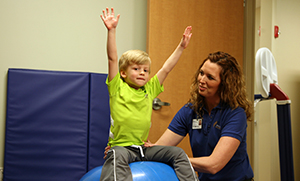Aquatic Therapy
Learn more about aquatic therapy at Memorial Hospital.
Why are aquatics important in physical therapy?
It’s a gentle way for people to get the same thing out of physical therapy as what they would do in the gym only it’s much more gentle on their body. When you think of physical therapy, a lot of people just think of sports rehab. Honestly, it’s so much more than that. Aquatic therapy is really being able to gently improve somebody’s strength, gently improve stretching their muscles, getting more range of motion out of a total joint replacement. We have strokes. We have traumatic brain injury patients. We have kids with cerebral palsy. These people don’t know how to walk, so we teach them how to walk. We teach them how to balance again in the most comfortable atmosphere.
How do you ensure patient safety in the pool?
We want to be in the pool with them so we know that they’re safe. We give them an overview when they first get into the pool, like the depths that they can move in and where the treadmill is at. We give them a run-through to make sure that: 1) they’re comfortable; 2) they know what their safety boundaries are, what their limitations would be, and how to make sure that we know that they’re comfortable as well. We’ve got some younger people who will come in, even sports athletes, and they have no problems, and some of those we just kind of leave it up to them if they need somebody there in the pool with them. We’ll be on the pool deck and still instructing them through the exercises just like they normally would be, but they’re able to just kind of have that space to themselves.
How does the pool help reduce pain for patients during therapy?
Let’s say I have a total hip patient who isn’t doing good in the gym, whether it be for pain or they’re just not getting the range of motion that the doctor is requiring, as long as their incision is healed they’re candidates to get in the pool to where we do kind of the same thing. We can stand them in the parallel bars when they’re in the gym, and we can do hip exercises like squats, knee bends, things like that, but they’re going to be too painful because they don’t have that range of motion yet. When we put them in the pool because they have buoyancy-assisted movement, suddenly they can go deeper on the squats. They can stand longer on their legs. They can bend farther on that knee. When we have them sitting on the bench or sitting on the stairs, we also have a platform that we can have them step on to actually mimic stairs and the range of motion that they would normally get in that frame. But again, it’s all pain-free because they don’t have all that weight on the joint.
Talk about the underwater treadmill.
The treadmill is good for balance and gait. A lot of them will have gait abnormalities where they’re limping on that one side. Once we have them on the treadmill, because it’s deeper in the water, they can walk without any injury. We can work on longer strides, planting more weight on that hip, planting more weight on that knee, or bending the knee through more when they’re stepping. All that comes into play when they get out of the water. Then they realize, “Oh I can do this a little bit longer or better.”
Discuss the importance of teamwork during aquatic therapy.
We have a lot of teamwork with some of our kiddos. We had a patient with cerebral palsy who was not audible (she didn’t have a voice) so she was very relaxed as far as head control, body control, so both of us were in there working with her together. It makes it easier because then physical therapy and occupational therapy can team up and help her get to her goals in that same environment. She’s in the comfort of the water. It’s nice and warm. She’s playing. She’s having a good time, but at the same time, she’s working whether she realizes it or not. But we all work together as a team in that aspect.


